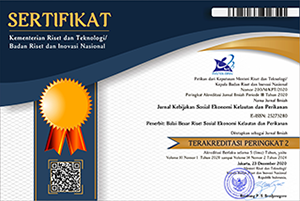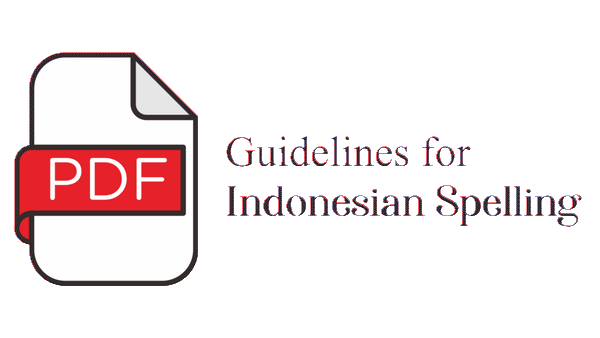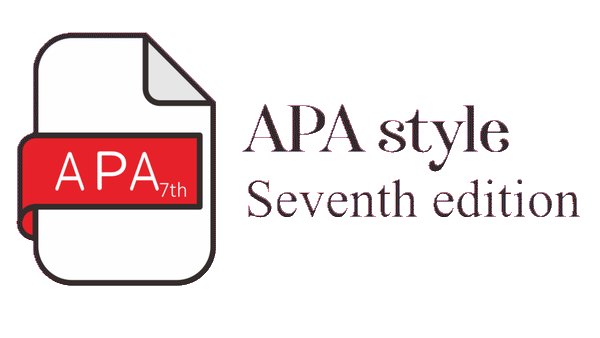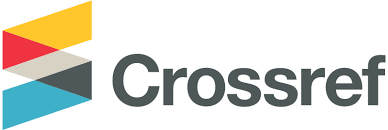ANALISIS POTENSI KEBERLANJUTAN MULTI USAHA SUB SEKTOR PERIKANAN DI KABUPATEN SIDOARJO
Abstract
Permasalahan sektor perikanan saling terkait antar sub sektor perikanan tangkap, budidaya, serta olahan dan pemasaran hasil perikanan. Penelitian bertujuan menganalisis potensi keberlanjutan usaha multi sub sektor perikanan skala kecil - menengah oleh masyarakat di Kabupaten Sidoarjo. Penelitian deskriptif dilaksanakan April 2015 s/d April 2018. Survey terestris dengan teknik rekam data tertutup dan terarah menggunakan alat bantu kuesioner. Data diberi bobot dan dianalisa menggunakan analisis shift share dan statistik untuk mengetahui keterkaitan antar sub sektor perikanan terhadap potensi keberlanjutannya. Hasil analisis keberlanjutan usaha tangkap (kode 01.T) bernilai terendah 2,3529 gap 6,0 dari nilai tertinggi 8,3529. Nilai regresi usaha penangkapan ikan Y = 0,005 + 0,961 X menunjukkan usaha penangkapan ikan belum mampu memberdayakan sektor lain. Tingkat signifikansi uji T tidak nyata 22,2%. Nilai R Square 0,005 dan Adjusted R Square -0,061 merepresentasikan tingkat kepercayaan usaha penangkapan ikan sangat rendah. Keberlanjutan usaha perikanan budidaya di tambak (simbol 02.Y) bernilai terendah 2,9783. Nilai regresi linier sebesar Y = 0,980 + 3,375 X menunjukkan usaha budidaya memberikan keberdayaan bagi sub sektor lain secara signifikan 97,8%*. Nilai R Square 0,225 dan Adjusted R Square 0,188 merepresentasikan keberlanjutan usaha budidaya kurang menjanjikan. Keberlanjutan olahan dan pemasaran hasil perikanan (kode 03.U) bernilai terendah 7,2600 dengan shift share gap positif 0,2600. Nilai regresi linier Y = 6,031 + 3,235 X signifikansi 100% menunjukkan usaha olahan dan pemasaran berpengaruh terhadap usaha lainnya, dengan nilai R Square 0,651 dan nilai Adjusted R Square 0,636. Hasil penelitian menyimpulkan bahwa sub sektor olahan dan pemasaran hasil perikanan berpeluang besar untuk ditumbuh-kembangkan.
Title: Analysis of Potential Sustainability of Multi Fisheries Sub Sector Business in the Sidoarjo Regency
The problems of fisheries sector are interrelated between the capture fisheries, cultivation, processing and marketing of fishery products. The research aims to analyze the potential sustainability of small and medium scale multi sub-sector fisheries businesses by people in Sidoarjo Regency. Descriptive research was conducted from April 2015 to April 2018. Terrestrial survey with closed data recording techniques and questionnaires were used in the study. Data were measured and analyzed using shift share matrix and statistics to find out the relation between fisheries sub-sectors to their potential sustainability. Results of the capture business sustainability analysis (code 01.T) have the lowest value of 2.3529 gap 6.0 from the highest value of 8.3529. The regression value of fishing business Y = 0.005 + 0.961 X indicates that fishing businesses have not been able to empower other sectors. The significance level of the T test is not real 22.2%. The R Square value of 0.005 and Adjusted R Square -0.061 represents the relatively low level of trust in fishing businesses. The sustainability of aquaculture business in the pond (symbol 02.Y) has the lowest value of 2.9783. The linear regression value of Y = 0.980 + 3.375 X indicates that cultivation provides empowerment for other sub-sectors significantly of 97.8%*. The value of R Square 0.225 and Adjusted R Square 0.188 representing the sustainability of aquaculture is less promising. Sustainability of processed and marketing of fishery products (code 03.U) has the lowest value of 7.2600 with a positive shift
share gap of 0.2600. The linear regression value Y = 6.031 + 3.235 X 100% significance indicates that the processed business and marketing affect other businesses, with the value of R Square 0.651 and the value of Adjusted R Square 0.636. It is concluded that the processed and marketing of fishery products subsector have a great opportunity to be developed.
Keywords
Full Text:
PDFReferences
Atmodjo, W. (2011). Studi Penyebaran Sedimen Tersuspensi di Muara Sungai Porong Kabupaten Pasuruan. Buletin Oseanografi Marina. Edisi Oktober 2011.
Badan Pusat Statistik (BPS). (2016). Statistik Daerah Kabupaten Sidoarjo. Badan Pusat Statistik Kota Sidoarjo.
Bidayani, E., Soemarno, Harahab, N. & Rudianto. (2016). Implementation of Blue Economy Concept as The Efforts of Mangrove Resource Conservation in Sidoarjo Coastal Area, East Java, Indonesia. International Journal of Ecosystem, 6(2): 25-34. DOI: 10.5923/j.ije.20160602.01.
Hikmah, Z. (2008). Analisis Konflik Nelayan Dalam Pengelolaan Sumber daya Perikanan Selat Madura Dalam Perspektif Sosiologis Hukum (Studi Kasus Nelayan Batah Kecamatan Kwanyar, Kabupaten Bangkalan, Provinsi Jawa Timur). Program Studi Manajemen Bisnis dan Ekonomi Perikanan Kelautan. IPB. Bogor.
Istiqomah, T. (2016). Ishikawa Effect Rancang Bangun Biodiversitas Pesisir. Seminar Nasional Biodiversitas VI, Surabaya 3 September 2016. F-MIPA Universitas Airlangga. Surabaya.
Istiqomah, T. (2018a). Karakterisasi Ekonomi Pesisir Kabupaten Sidoarjo Berbasis Pengkayaan Keragaman Mangrove. Agrikan. Jurnal Universitas Muhammadiyah Ternate. IOSR Journal Of Environmental Science, Toxicology and Food Technology (IOSR-JESTFT). E-ISSN: 2319-2402.
Istiqomah, T. (2018b). Analisis Gender Peran Wanita Sebagai Stimulator Ekonomi Keluarga Nelayan di Pesisir Kabupaten Sidoarjo. Fish Scientiae. Jurnal Ilmu-ilmu Perikanan dan Kelautan, Vol. 8 No. 1 Juni 2018. ISSN: 1693-3710.
Mangkay, S. D., Harahab, N., Polii, B. & Soemarno. (2013). Economic Valuation of Mangrove Forest Ecosystem in Tatapaan, South Minahasa Indonesia. IOSR Journal Of Environmental Science, Toxicology And Food Technology (IOSR-JESTFT) e-ISSN: 2319-2402,p- ISSN: 2319-2399. Volume 5, Issue 6 (Sep. - Oct. 2013), PP 51-57.
J. Kebijakan Sosek KP Vol. 9 No. 1 Juni 2019: 1-10
Muhsonim, F.F., & Nuraini, C. (2006). Kajian Tingkat Pemanfaatan Sumber daya Ikan di Perairan Selat Madura Dengan Menggunakan Metode Holistik Serta Analisis Ekonominya. Jurnal Protein, Vol. 13 No. 1. Tahun 2013. Peraturan Daerah Kabupaten Sidoarjo No. 6 Tahun 2009. Rencana Tata Ruang Wilayah Kabupaten Sidoarjo Tahun 2009 – 2029.
Primyastanto, M., Efani A., Soemarno & Muhammad, S. (2013). Faktor yang Berpengaruh Terhadap Pendapatan dan Pengeluaran Nelayan Payang Jurung di Selat Madura. Wacana, Vol. 16, No. 1 (2013). ISSN: 1411-0199 E-ISSN: 2338-1884.
Rostin. (2016). The Effect of Economic Empowerment of the Coastal Communities and Social Capital on Coastal Community Welfare. The International Journal Of Engineering And Science (IJES). Volume 5 Issue 2 Pages PP 12-16. ISSN (e): 2319 – 1813 ISSN (p): 2319 – 1805.
Soedrijanto, A., & Istiqomah, T. (2016). Organic Black Tiger Shrimp Farming System (ISO 65 IFOAM): Strategy Through Open Spirit Reap Back to Nature. Journal of Aquaculture & Marine Biology, DOI: 10.15406/jamb.2016.04.00069
Shofa, S.U. & Navastara, A.M. (2015). Faktor Penentu Pengembangan Industri Pengolahan Perikanan Di Kabupaten Sidoarjo melalui Pengembangan Ekonomi Lokal. Jurnal Teknik, ITS Vol. 4, No. 2, (2015) ISSN:2337-3539 (2301-9271 Print). Perencanaan Wilayah dan Kota, Fakultas Teknik Sipil dan Perencanaan ITS Surabaya. Soedrijanto, A. (2012). Analisis Kawasan Konservasi Pesisir di Kabupaten Sidoarjo. Dinas Perikanan dan Kelautan Kabupaten Sidoarjo.
DOI: http://dx.doi.org/10.15578/jksekp.v9i1.7343
Indexed by:
---------------------------------------------------------------------------------------
Published by
Research Center for Marine and Fisheries Socio-Economic
in collaboration with
Indonesian Marine and Fisheries Socio-Economics Research Network
This work is licensed under a Creative Commons Attribution-NonCommercial-ShareAlike 4.0 International License.













3.png)











